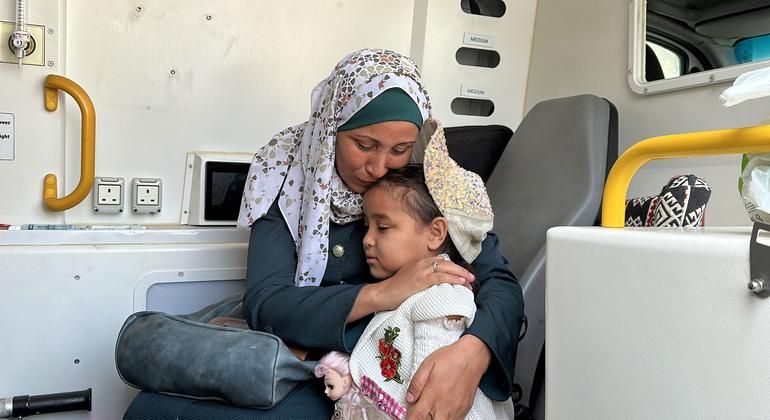In Khan Younis, the UN agency for Palestine refugees (UNRWA) reported witnessing “thousands of people fleeing” westwards as part of the exodus from the southern town of the enclave amid ongoing hostilities, leaving children traumatised and crying uncontrollably.
“Elderly people on the back of donkey carts… disabled people pushed in wheelchairs through the sand “People are piled up with their belongings on their laps,” said Louise Wateridge, UNRWA senior communications officer. “People are running, Hearing gunshots [and] Running for their lives“Families only take with them what they can hold in their hands… People don’t know where to go. That’s the main question people are asking today: ‘Where do I go?’”
Al Mawasi shrank
Israel's evacuation orders have also affected some 8.7 square kilometers of land in the so-called “humanitarian zone” of Al Mawasi, which lies on the coast near Khan Younis, reducing the size of the zone by nearly 15 percent, according to the UN's aid coordination office, OCHA.
“Initial reports indicate that families are currently moving towards areas of Deir al-Balah and western Khan Younis,” OCHA said. “Both areas are under threat of They are already severely overcrowded, have limited shelters and services available and can barely accommodate the additional influx of displaced people..
As of July 22, nearly 83 percent of the Gaza Strip has been placed under evacuation orders or designated as a “no-go zone” by the Israeli military.
Condemnation by the UN Human Rights Office
Condemning the “repeated” evacuation orders, the UN human rights office, OHCHR, insisted that the Israeli military had not given civilians “time” to understand where they were expected to leave or where they should go.
At least 70 Palestinians, including women and children, were killed in the violence on Monday, the UN human rights office said, citing local health authorities. At least 200 others were injured, some seriously, amid reports of intensified Israeli airstrikes on Khan Younis since Sunday, with “multiple” attacks on Monday and an “intensification” of shelling in the east of the city.
“Israeli military operations continued unabated in and around the area,” OHCHR said, noting that the evacuation order covered parts of the Salah al-Deen Road, “one of the two main vital routes for the transport and distribution of aid, raising concerns that the delivery and provision of desperately needed humanitarian assistance may be further curtailed or impeded.”
Alert update on polio outbreak
Meanwhile, concerns continue to grow over the impact of a possible polio outbreak in Gaza, amid dire sanitary conditions and a lack of access to medical care.
Dr. Ayadil Saparbekov, head of the United Nations World Health Organization (WHO) health emergency team in the occupied Palestinian territory, said on Tuesday that he was “extremely concerned” about the Spread of polio and other communicable diseases, which could result in more people dying from preventable diseases than from war-related injuries.
Hepatitis A was already confirmed last year in the Strip, he told reporters via video link from Jerusalem.
“With the health system paralyzed, the lack of water and sanitation, as well as the lack of access to health services for the population… the situation is going to be very bad,” he said. “More people may die from various contagious diseases than from injury-related conditions.”
On 16 July, WHO said that vaccine-derived poliovirus type 2 (VDPV2) had been identified at six locations in wastewater samples collected on 23 June in Khan Younis and Deir Al-Balah.
The WHO explained last week that the polio virus can emerge in areas where poor vaccination coverage allows the weakened form of the virus strain in the orally administered vaccine to mutate into a stronger version.
So far, the virus has only been detected in sewage samples and no one in Gaza has been identified with polio-induced paralysis. Additional genomic sequencing by the US Centers for Disease Control and Prevention (CDC) in Atlanta indicated that the virus is linked to a strain that circulated in Egypt during the second half of 2023, the WHO said.
Dr Saparbekov explained that human samples have not yet been collected, as there is a lack of equipment and laboratory capacity to analyse them. A WHO team will arrive in Gaza on Thursday with up to 50 sample collection kits and send them to a laboratory in Jordan for further analysis.
The WHO official said that together with its partners, the agency is conducting an epidemiological investigation and risk assessment to identify the source of the virus, which has a high risk of spreading within Gaza and internationally.
“Based on the results of the evaluation, WHO and the [Global Polio Initiative Network] “Partners will consolidate a set of recommendations, including the need for a mass vaccination campaign,” he said.
Dr Saparbekov stressed that given the water, sanitation and hygiene situation in Gaza, it will be “very difficult” for people to follow advice on handwashing and drinking safe water.
“Unfortunately, most people living in shelters with one bathroom for 600 people and maybe 1.52 liters of water per person will definitely not be able to follow the recommendations,” he said.
The UN health agency representative also insisted that if a mass vaccination campaign is decided upon, It will be the responsibility of COGAT, the Israeli agency responsible for the flow of aid in Gaza, to facilitate the arrival of vaccines. in the enclave.
He added that the WHO “has so far received assurances that this will be done.”
The health system is closed
Regarding the devastation of Gaza's health system, Dr. Saparbekov said that less than half of primary health care centers are operational and only 16 of the enclave's 36 hospitals are “partially functional,” meaning they provide only minimal health care services, such as triaging the wounded.
On Monday, WHO and its partners conducted a mission to Al-Shifa Hospital in Gaza City, where they have been rehabilitating the outpatient department, destroyed in March 2024, and converting it into an emergency department.
“The only functional team that unfortunately remains in Gaza [at Al Shifa hospital] “This is a stationary X-ray machine,” Dr. Saparbekov explained. “All other important equipment in the hospital, such as respirators, anesthesia machines and operating room equipment, have unfortunately been destroyed and need to be replaced.”
The WHO and its partners are “working tirelessly” to ensure that the much-needed equipment reaches Gaza despite “dual-use list restrictions,” he said – items that are banned from entering the enclave because Israeli authorities believe they could be reused for military purposes.












